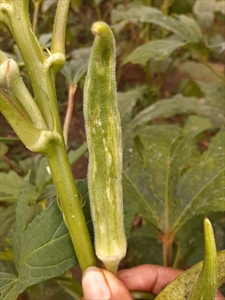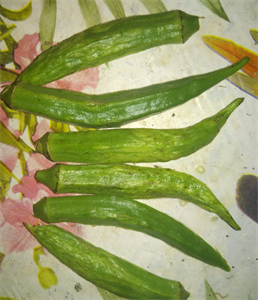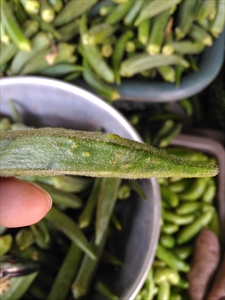Okra bumps and ridges.
Pacific Pests, Pathogens, Weeds & Pesticides - Online edition
Pacific Pests, Pathogens, Weeds & Pesticides
Okra bumps & distortions (432)
Unknown cause
Asia, North America, Oceania. It is recorded from Fiji.
Okra (Abelmoschus esculenta).
Irregular bumps or ridges up to 12 mm long and 2-3 mm wide some in lines parallel to the length of the pod, whitish to green, occasionally developing brownish centres as they age (Photo 1). In severe cases, large areas of the fruits pods are affected causing distortions (Photo 2). Internally, the seeds and other parts appear healthy (Photos 3&4). Similar symptoms have been seen in India (Photo 5). There is no pattern of the condition in the field: it occurs scattered throughout plantings.
Several causes have been suggested:
- Stink bug ‘stings’, inserting feeding tubes through the fruit wall into the seeds
- Nutrient deficiency, possibly boron
- Virus, possibly Okra yellow vein virus.
In Fiji, the problem is becoming serious, and there is concern because pod distortion is affecting quality, especially on export markets. Biosecurity authorities in importing countries are interested to know if the bumps represent a hitherto unrecorded pathogen of okra.
Look for the bumps on the okra pods, irregular in shape, single or in lines along the pods, white, green, possibly browning with age. Look to see that the seeds are healthy.
Until the cause of the condition is known, no recommendations can be provided.
AUTHOR Grahame Jackson & Mani Mua
Walter Reeves The Georgia Gardener. Okra - Edible with bumps on pods. (https://www.walterreeves.com/food-gardening/okra-edible-with-bumps-on-pods/).
Produced with support from the Australian Centre for International Agricultural Research under project HORT/2016/185: Responding to emerging pest and disease threats to horticulture in the Pacific islands, implemented by the University of Queensland and the Secretariat of the Pacific Community.








